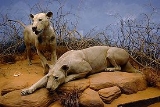
Tsavo maneaters
Overview
The Tsavo Man-Eaters were a pair of notorious man-eating
lion
s responsible for the deaths of a number of construction workers on the Kenya-Uganda Railway, from March through December 1898.
In March 1898 the British
started building a railway bridge over the Tsavo River
in Kenya
. The project was led by Lt. Col. John Henry Patterson
. During the next nine months of construction, two maneless male Tsavo lion
s stalked the campsite, dragging Indian workers from their tents at night and devouring them.
Man-eater
Man-eater is a colloquial term for an animal that preys upon humans. This does not include scavenging. Although human beings can be attacked by many kinds of animals, man-eaters are those that have incorporated human flesh into their usual diet...
lion
Lion
The lion is one of the four big cats in the genus Panthera, and a member of the family Felidae. With some males exceeding 250 kg in weight, it is the second-largest living cat after the tiger...
s responsible for the deaths of a number of construction workers on the Kenya-Uganda Railway, from March through December 1898.
In March 1898 the British
United Kingdom
The United Kingdom of Great Britain and Northern IrelandIn the United Kingdom and Dependencies, other languages have been officially recognised as legitimate autochthonous languages under the European Charter for Regional or Minority Languages...
started building a railway bridge over the Tsavo River
Tsavo River
The Tsavo River runs east from the western end of the Tsavo National Park of Kenya, near the border of Tanzania, until it joins with the Athi River, forming the Galana River near the center of the park. This river is the main contributor to the watershed of the lower portion of the park region, and...
in Kenya
Kenya
Kenya , officially known as the Republic of Kenya, is a country in East Africa that lies on the equator, with the Indian Ocean to its south-east...
. The project was led by Lt. Col. John Henry Patterson
John Henry Patterson (author)
Lieutenant-Colonel John Henry Patterson, DSO , known as J.H. Patterson, was an Anglo-Irish soldier, hunter, author and Zionist, best known for his book The Man-Eaters of Tsavo , which details his experiences while building a railway in Kenyain 1898-99...
. During the next nine months of construction, two maneless male Tsavo lion
Tsavo lion
Tsavo lions are a distinct variety of lion living around the Tsavo River in the Tsavo National Park in Kenya. Tsavo males are notable for their lack of mane and smooth pelt, their size, and that they actively participate in hunting...
s stalked the campsite, dragging Indian workers from their tents at night and devouring them.
Discussions

